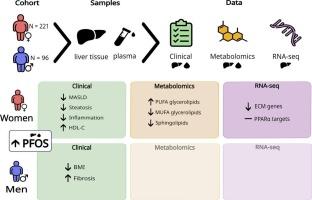人类肝脏全氟辛烷磺酸与脂肪变性肝病以性别依赖的方式相关
IF 9.7
1区 环境科学与生态学
Q1 ENVIRONMENTAL SCIENCES
引用次数: 0
摘要
全氟辛烷磺酸(PFOS)是一种在环境中发现的持久和广泛存在的污染物,因此也存在于人体内,并与包括脂肪变性肝病(SLD)在内的不利健康影响有关。关于全氟辛烷磺酸在SLD中的作用的人体研究主要是流行病学研究,依赖于血浆,而没有测量肝脏的全氟辛烷磺酸。然而,使用血浆全氟辛烷磺酸水平来评估脂肪肝疾病是不全面的,全氟辛烷磺酸对人类肝脏的影响尚未得到描述。我们研究了血浆中PFOS (P-PFOS)和肝脏中PFOS (L-PFOS)与代谢功能障碍相关SLD (MASLD)临床参数的关系,研究对象为肥胖和组织学证实的MASLD。结合肝脏RNA-seq和肝脏和血浆代谢组学数据,我们将L-和P-PFOS与mRNA转录物和代谢物相关联,以确定失调的转录和代谢途径。在女性中,l -全氟辛烷磺酸与MASLD患病率和严重程度呈负相关。相反,在男性中,P-PFOS和L-PFOS与纤维化呈正相关。l -全氟辛烷磺酸四分位数分析显示,仅在男性的几个组织学参数中存在潜在的阈值效应。在女性中,l -全氟辛烷磺酸与MASLD进展相关途径的代谢物负相关,包括二酰基甘油和鞘脂类。在基因表达水平上,仅在女性中,L-PFOS与许多参与胶原形成和细胞外基质组织的纤维化相关基因呈负相关。一般来说,l -全氟辛烷磺酸与女性的许多疾病相关变量相关,但与男性相关的变量很少。女性中的这些相关性与MASLD进展中的临床和分子变化相反,而男性中L-PFOS与肝纤维化之间的正相关表明与肝脏疾病呈正相关本文章由计算机程序翻译,如有差异,请以英文原文为准。

Human liver perfluorooctane sulfonate associates with steatotic liver disease in a sex-dependent manner
Perfluorooctane sulfonate (PFOS) is a persistent and widespread contaminant found in the environment and, as a consequence, in the human body, and is linked to adverse health effects, including steatotic liver disease (SLD). Human studies on the role of PFOS in SLD have been largely epidemiological, relying on plasma without measuring liver PFOS. However, using plasma PFOS levels to evaluate fatty liver disease is not comprehensive, and the effects of PFOS in human liver have not been described. We investigated the association of PFOS in plasma (P-PFOS) and liver (L-PFOS) with clinical parameters of Metabolic dysfunction-Associated SLD (MASLD) in a large human cohort with obesity and histology-confirmed MASLD. Combining liver RNA-seq and metabolomic data from liver and plasma, we correlated L- and P-PFOS with mRNA transcripts and metabolites to identify dysregulated transcriptional and metabolic pathways. In women, L-PFOS negatively correlated with MASLD prevalence and severity. Conversely, in men, P-PFOS and L-PFOS positively associated with fibrosis. L-PFOS quartile analysis showed potential threshold effects in several histological parameters in men only. In women, L-PFOS negatively correlated with metabolites from pathways implicated in MASLD progression, including diacylglycerol and sphingolipid species. At the gene expression level, L-PFOS correlated negatively with many fibrosis-related genes involved in collagen formation and extracellular matrix organization in women only. Generally, L-PFOS correlated with many disease-relevant variables in women, but with few in men. These correlations in women were opposite the clinical and molecular changes seen in MASLD progression, while the positive correlation between L-PFOS and liver fibrosis in men suggests a positive relationship with liver disease
求助全文
通过发布文献求助,成功后即可免费获取论文全文。
去求助
来源期刊

Environment International
环境科学-环境科学
CiteScore
21.90
自引率
3.40%
发文量
734
审稿时长
2.8 months
期刊介绍:
Environmental Health publishes manuscripts focusing on critical aspects of environmental and occupational medicine, including studies in toxicology and epidemiology, to illuminate the human health implications of exposure to environmental hazards. The journal adopts an open-access model and practices open peer review.
It caters to scientists and practitioners across all environmental science domains, directly or indirectly impacting human health and well-being. With a commitment to enhancing the prevention of environmentally-related health risks, Environmental Health serves as a public health journal for the community and scientists engaged in matters of public health significance concerning the environment.
 求助内容:
求助内容: 应助结果提醒方式:
应助结果提醒方式:


